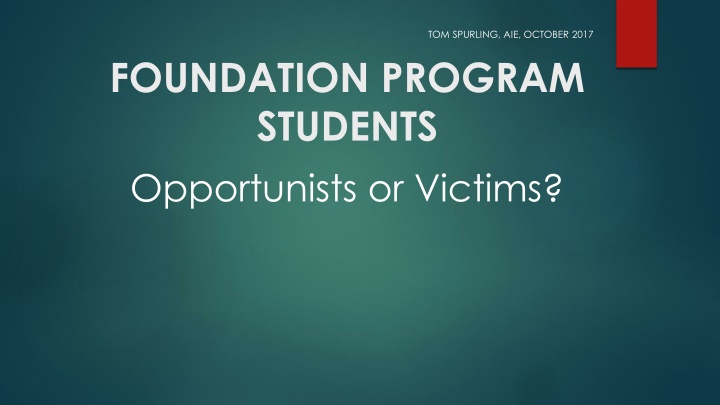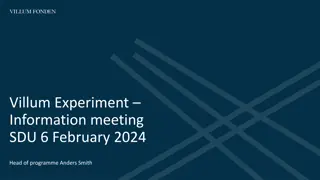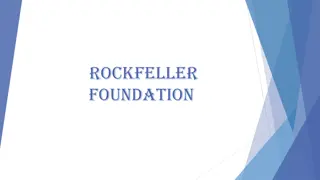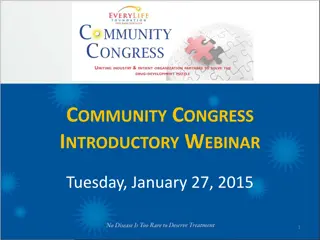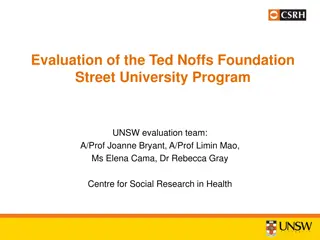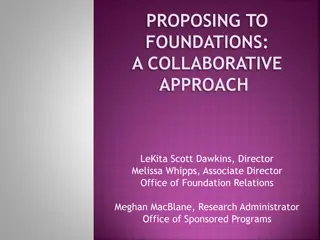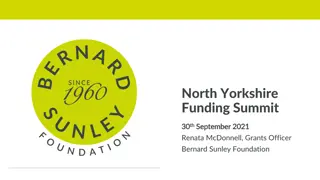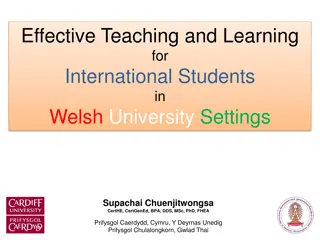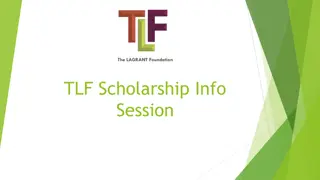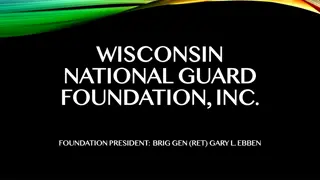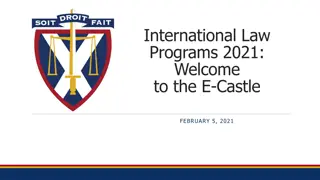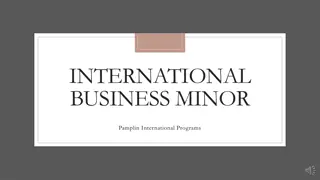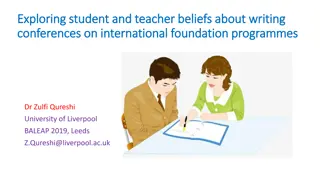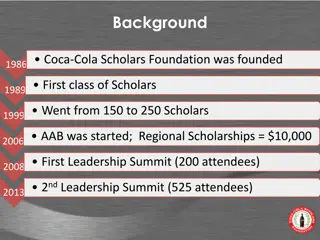Challenges and Opportunities Faced by International Foundation Program Students
The article explores the experiences of international students in Foundation Programs, discussing their challenges in transitioning to higher education and the implications for global education. It highlights the importance of documenting these experiences, the rise of the international education industry, and the impacts of globalization on tertiary enrollment and cultural exchange.
Download Presentation

Please find below an Image/Link to download the presentation.
The content on the website is provided AS IS for your information and personal use only. It may not be sold, licensed, or shared on other websites without obtaining consent from the author.If you encounter any issues during the download, it is possible that the publisher has removed the file from their server.
You are allowed to download the files provided on this website for personal or commercial use, subject to the condition that they are used lawfully. All files are the property of their respective owners.
The content on the website is provided AS IS for your information and personal use only. It may not be sold, licensed, or shared on other websites without obtaining consent from the author.
E N D
Presentation Transcript
TOM SPURLING, AIE, OCTOBER 2017 FOUNDATION PROGRAM STUDENTS Opportunists or Victims?
Key questions What are they? How do international students deal with the transition? What can their experiences teach us about how we internationalise our own schools?
An excerpt from Concise Chinese-English Dictionary for Lovers by Guo Xiaolu What else I knowing about West? American TV series dubbing into Chinese, showing us big houses in suburb, wife by window cooking and car arriving in front house. Husband back work. Husband say Honey I home, then little childrens running to him, see if he bringing gift. But that not my life. That nothing to do with my life. I not having life in West. I not having home in West. I scared. I no speaking English. I fearing future. As I far away from China, I asking me why I coming to West. Why I must to study English like parents wish? Why I must to get diploma from West? I not knowing what I needing. Sometimes I not even caring what I needing. I not caring if I speaking English or not. Mother only speaking in village dialect and even not speaking official Mandarin, but she becoming rich with my father, from making shoes in our little town. Life OK. Why they want changing my life? And how I living in strange country West alone? I never been to West. Only Western I seeing is man working in Beijing British Embassy behind tiny window. He stamp visa on brand new passport.
What are Foundation Programs? Foundation Programmes (FPs) Courses designed for international students to equip them with the skills and capabilities to seek entry into higher education programs - Bridging courses - 12-month programmes - Private providers Back-door entry? GRIBBLE, 2014 Generally considered suitable academic pathways, though media reports mixed AUSTRALIAN EDUCATION INTERNATIONAL, 2014
Why study Foundation Program students? The rise of international education industry Need to better document experiences of students crossing borders in search of post-compulsory qualifications Drastic social, academic and cultural challenges Under-represented
Globalisation PROS Global gross tertiary enrolment ratio (GTER) went up from 14% in 1992 to 32% in 2012, compared with just a four percentage point rise in the previous 20 years Sharp enrolment increases OECD EDUCATION AT A GLANCE REPORT, 2014 Access to the fruits of globalisation employment, wealth, a place in the global village Philosophical grounding in cosmopolitan virtues SCHOTTLE, 2010; CAMBRIDGE, 2011; ALTINAY, 2010 Shift in work: agriculture to services (urban, online technology) Increased mobility MARGINSON IN GROVE, 2015
Globalisation CONS Spectre of neoliberalism (market dictates everything) Students have become relegated to the status of consumers, and in turn products for the global economy BALDWIN & JAMES, 2010 The resultant privatisation of education may pressure institutions to move students through courses at a rate dictated by the market CLARKE, 2012 Flattening of cultures; shifting identities
Australia: a brief history of international education (1/3) 1950 Colombo Plan (more than 20,000 students) This increase occurred despite "anxiety about decolonisation and the persistence of Australia's restrictive immigration or 'White Australia' policy" LOWE, 2011 1973 The abandonment of the controversial White Australia policy 1974-1988 Whitlam government abolished university fees 1986 Overseas Student Charge (OSC) - pre-cursor to current fee structure for international students
Australia: a brief history of international education(2/3) 1990s Tertiary budgets were significantly reduced and the status of international students shifted from cultural luxury to economic necessity. Education as 'trade' to education as 'internationalisation CUTHBERT, SMITH & BOEY, 2008 Commercially oriented nature of industry undermined efforts at soft diplomacy BYRNE AND HALL, 2013 2009 Attacks on Indian students in Melbourne
Australia: a brief history of international education (3/3) 2011Knight Review recommended an overhaul of the country s student visa program Call for trans-national citizenship rights RAMIA, MARGINSON AND SAWIR, 2013 2012The Asian Century White Paper 2013 Australia Education Globally report 2014New Colombo Plan 2018 New national Code 2018 international student protection
Current issues in international education in Australia High growth in international student recruitment but low provision for their needs - a warning for future policymakers Objective to fast-track young, Australian-educated and English- proficient graduates into specific areas of skills shortage (past two federal govts) Unintended consequences - The changing demographics of students seeking Permanent Residency - The emergence of recruitment agencies, student accommodation providers, 'boutique' education institutions and a cheap labour force
Emotional / learning challenges for FP students Chinese Learner? HUI et al 2011 Pressure of filial piety A young man, bored and ashamed of his parents, but also ashamed of being ashamed of his parents. Is there an intelligent young person alive who doesn t recognize that? REVIEW Of GERARD REVE S THE EVENINGS Fixed academic intelligence? WANG & NG, 2012 Attitudes of host country students MAK, BROWN & WADEY, 2014; RUBLE & ZHANG, 2013 Ronnie Chieng: https://www.youtube.com/watch?v=q5HSsrjoedk Authentic representation of international student experience?
What are the limitations of the FP experience? FPs are the fringe dwelling international students and their experience can teach us a lot about how we internationalise our schools FP students are often viewed as deficient , either in host language ability, or in the quality of home country qualification. This deficiency model is problematic and must be challenged 1. FP students are not fully embraced by mainstream universities. They have some access, by it is typically restricted 2. Opportunities for meaningful interactions with local students are often non-existent 3. Easy money for tertiary providers. $20-25k per year for no formal qualification. Often dubious academic progress and standards 4. FP students learning difficulties are often transferred to the partner university. The student graduates into university, often significantly underprepared 5. There is a tendency for older and/or weaker students to be dumped into FPs 6. Some FP students see it as a backdoor entry to PR. Exploit system 7.
And the positives? Academic skills are fast tracked Host language skills improve (in most cases) For many motivated students, the FP is a powerful bridge to university success (esp. Singaporean, Malaysian, Indonesian, but also many Chinese and other nationalities) Alternative Year 12 a safe, manageable transition into the host country s educational, cultural and social system
What does this mean for schools seeking to internationalise ? (1/2) We need to be accountable for why we exclude certain demographics of students. Is user pays enough? If not, why not? What university pathways does your school encourage? And why? Do you consider FPs as viable pathways for your students? Should the role of high school be to teach general academic skills (research, referencing, editing), in addition to subject content and IB-style soft skills? Or is the curriculum just too busy? Should international schools stream into FP-type pathways?
What does this mean for schools seeking to internationalise ? (2/2) Could high schools provide a Foundation Year equivalent for international students seeking entry into a university but who not yet at the requisite language level? What s the relationship in values between high school and university in terms of access? Is there a clash? Is the shift too severe? Personal agency how to teach it Relationships with staff & local students how to foster them How are local governments responding to the social needs of international students? Whose responsibility are they?
Thank you for listening. tom.spurling@student.uwa.edu.au thomas_spurling@aishk.edu.hk
